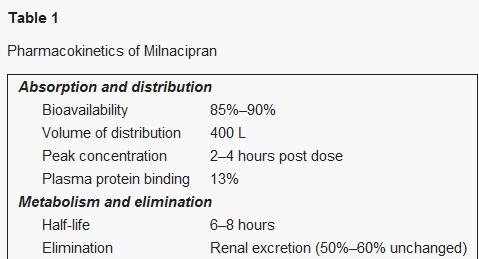Milnacipran is indicated for the management of fibromialgia in adults.
CONTRAINDICATIONS AND PRECAUTIONS
The use of milnacipran in patients with uncontrolled narrow-angle glaucoma is contraindicated. Milnacipran has been associated with an increased risk of mydriasis. Pupil dilation can restrict the flow of aqueous fluid, causing buildup behind the iris. If blockage occurs, a rapid rise in intraocular pressure can occur.
The concomitant use of milnacipran and MAO inhibitors is contraindicated because of the increased potential to cause serotonin syndrome and hypertensive crisis.
Milnacipran carries a boxed (black-box) warning for an increased risk of suicidal ideation, thinking, and behavior in children, adolescents, and young adults. This medication should not be prescribed to patients who are actively suicidal.
Reports suggest that selective serotonin reuptake inhibitors (SSRIs) and SNRIs, when used as monotherapy, can cause serotonin syndrome and neuroleptic malignant syndrome (NMS)–like reactions. Clinicians should be alert to any possible symptoms relating to either of these syndromes.
Increases in blood pressure (BP) and heart rate have been associated with milnacipran. The drug should be prescribed with caution if patients have uncontrolled, elevated BP and if they are taking other medications (e.g., psychostimulants) that can increase BP.
Milnacipran has also been associated with mild elevations in liver enzymes. Therapy should be discontinued if there is evidence of liver dysfunction.
ADVERSE DRUG EFFECTS
In placebo-controlled trials, the most commonly noted AE was nausea. Other frequently experienced side effects included constipation, hot flushes, hyperhidrosis, vomiting, palpitations, increased heart rate, dry mouth, and hypertension. AEs leading to discontinuation of treatment doses of milnacipran in placebo-controlled trials consisted of nausea (6%), palpitations (3%), headache (2%), constipation (1%), increased heart rate (1%), hyperhidrosis (1%), vomiting (1%), and dizziness (1%).
In phase 3 trials, weight loss occurred at a greater rate in patients receiving milnacipran in comparison with placebo. A mean weight loss of approximately 0.8 kg was reported for milnacipran, compared with 0.2 kg for placebo.
DRUG INTERACTIONS
In clinical trials, hypertension was approximately doubled in patients who received milnacipran compared with those receiving placebo. Those patients in the 100-mg treatment group were more likely to become hypertensive (19.5%) than those receiving 200 mg/day (16.6%) or placebo (7.2%). Heart rate was also reported to be increased by an average of 7 to 8 bpm with milnacipran use.
Most of the milnacipran dose is metabolized predominantly through phase 2 conjugation, which reduces the possibility of interactions with drugs metabolized through CYP 450 enzymes.10 Although milnacipran is metabolized primarily through glucuronidation, the drug is a substrate and a weak inhibitor of CYP 3A4.12 This known inhibition is unlikely to produce any clinically relevant pharmacokinetic drug interactions.
Pharmacokinetic drug interactions involving CYP isoenzymes are not likely with milnacipran use, but several clinically important pharmacodynamic interactions must be considered. As previously mentioned, MAO inhibitors are contraindicated with milnacipran. Caution should be exercised with other agents such as antidepressants online, anti-psychotic drugs, and lithium, because these agents can precipitate 5-HT and NMS-like syndromes. Medications that increase BP and heart rate should also be used cautiously in patients receiving milnacipran because of its potential hypertensive effects.

